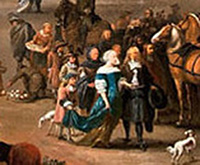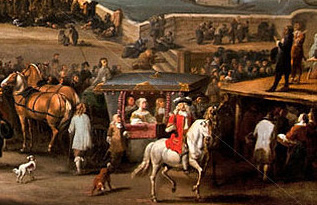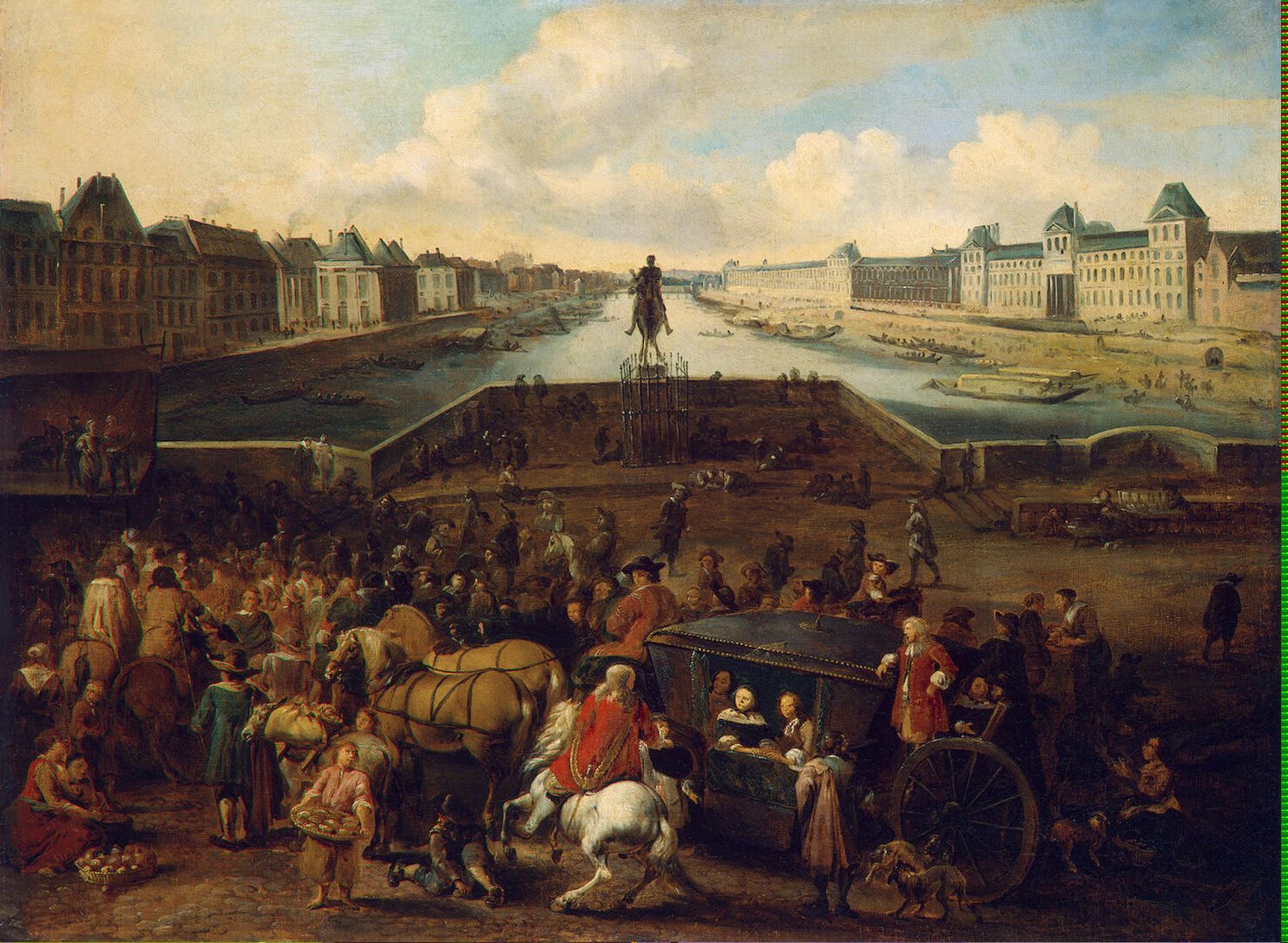Social Classes Meet on the Pont Neuf
Joan DeJean, How Paris Became Paris: The Invention of the Modern City (New York: Bloomsbury,2014), pp.26-30
The imposing effigy [the statue of Henri IV on the Pont Neuf] may have reminded the people of Paris of the century's opening decade when, thanks to Henri IV's vision, their city was rushing headlong into a new age. Parisians immediately turned the novel kind of monument into the most popular meeting place in the city. They created expressions such as "let's meet by the Bronze King," or "I'll wait for you beneath the Bronze Horse." We know details such as these, and we know about the strain of civic pride that the statue awakened, because the Bronze King was celebrated extensively in print: already in 1614, small, inexpensive books designed to appeal to a wide audience began to advertise the fact that Paris, which now had an equestrian statue like the great cities of antiquity, was taking over their role as "the most famous city under the heavens."
The enthusiasm with which Parisians welcomed the bridge helps explain why it  became one of those rare public works that actually shape urban life. On the New Bridge, Parisians rich and poor came out of their houses and began to enjoy themselves in public again after decades of religious violence. The Pont Neuf became the first truly communal entertainment space in the city: since access cost nothing, it was open to all. The greatest nobles disported themselves in ways amazingly unorthodox for a setting where anyone could see them. In February 1610, the sixteen-year-old Due de Vendome (Henri IV's illegitimate son) was seen running around on the bridge engaged in a "heated battle with snowballs."
became one of those rare public works that actually shape urban life. On the New Bridge, Parisians rich and poor came out of their houses and began to enjoy themselves in public again after decades of religious violence. The Pont Neuf became the first truly communal entertainment space in the city: since access cost nothing, it was open to all. The greatest nobles disported themselves in ways amazingly unorthodox for a setting where anyone could see them. In February 1610, the sixteen-year-old Due de Vendome (Henri IV's illegitimate son) was seen running around on the bridge engaged in a "heated battle with snowballs."
And on the other end of the social spectrum, it was at the base of the Pont Neuf that public bathing in the Seine became popular, giving the least fortunate Parisians the chance to cool off from the summer heat. Soon after the bridge was opened, bathers and sunbathers began to congregate just below the bridge, in full view of all those crossing the Seine. The activity became more organized when bathing boats started to dock there, separate ones for women and for men. . . .
 Since everyone from princes to paupers crossed paths on the bridge, Parisians thus got their first real taste of an experience that touched the inhabitants of other European capitals only decades later: close physical contact with strangers, in particular with individuals completely outside their social sphere. The numerous seventeenth-century canvases that represent the scene on the bridge showcase this radical social mixing. In this detail from a painting from the 1660s, for example, a pair of aristocrats is seen moving comfortably in the same space with bourgeois (the woman just behind them, the man on horseback) and even lowly street peddlers. (The man shown bending over is selling apples, but the woman's basket might contain the chestnuts, famous all over Europe, that were a specialty of bridge venders.) And just behind those strolling aristocrats are visible what are literally huddled masses: paupers who have taken refuge beneath the equestrian statue. In addition, the aristocrats are taking in the scene in the same manner as less privileged Parisians, on foot. The Pont Neuf was a great social leveler.
Since everyone from princes to paupers crossed paths on the bridge, Parisians thus got their first real taste of an experience that touched the inhabitants of other European capitals only decades later: close physical contact with strangers, in particular with individuals completely outside their social sphere. The numerous seventeenth-century canvases that represent the scene on the bridge showcase this radical social mixing. In this detail from a painting from the 1660s, for example, a pair of aristocrats is seen moving comfortably in the same space with bourgeois (the woman just behind them, the man on horseback) and even lowly street peddlers. (The man shown bending over is selling apples, but the woman's basket might contain the chestnuts, famous all over Europe, that were a specialty of bridge venders.) And just behind those strolling aristocrats are visible what are literally huddled masses: paupers who have taken refuge beneath the equestrian statue. In addition, the aristocrats are taking in the scene in the same manner as less privileged Parisians, on foot. The Pont Neuf was a great social leveler.
None of this was lost on contemporary commentators, who understood that the bustle and the diversity of the original urban crowd could be both a tourist attraction and a source of civic pride. In 1652, Parisian writer Claude Louis Berthod explained to friends in the provinces that he wasn't going to bore them with still another account of the grand monuments of Paris. Instead, he was going to tell them about the real Paris, "a place full not of marvels but of chaos and commotion." He began his account with the Pont Neuf and its role as a social equalizer. In his 1684 guidebook to the city, Brice observed that visitors were perpetually surprised by "how busy and crowded" the bridge was and the fact that on it "one encountered people from every rank and dressed in every possible way." He concluded that "all this gives a great and magnificent idea of Paris."

Hendrick Mommers, The Louvre as Seen from the Pont-Neuf (1666)